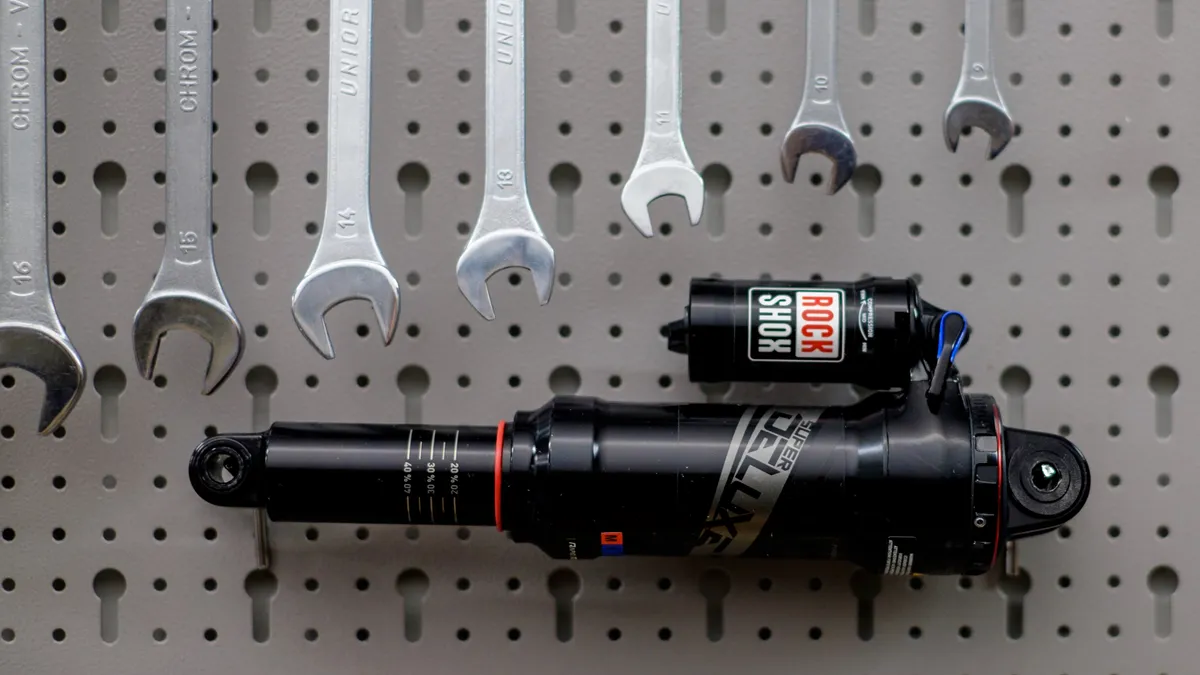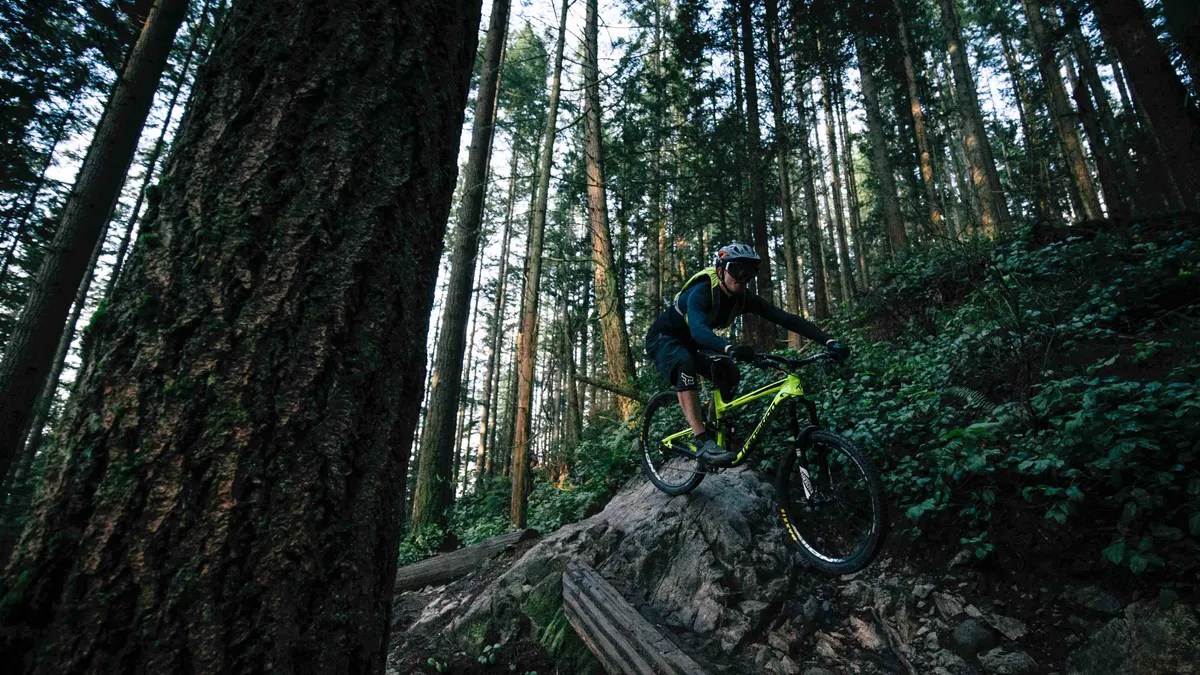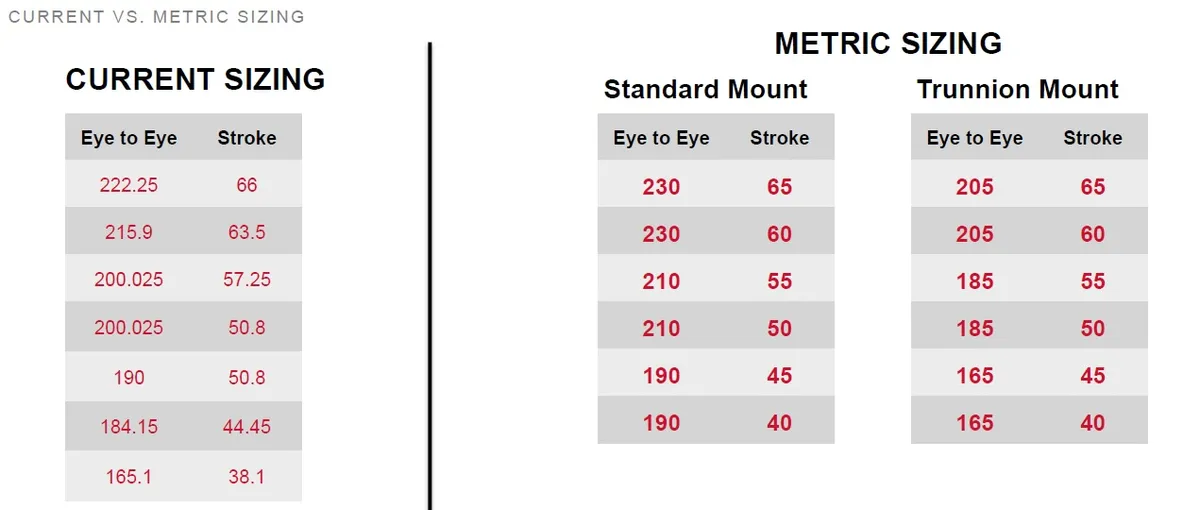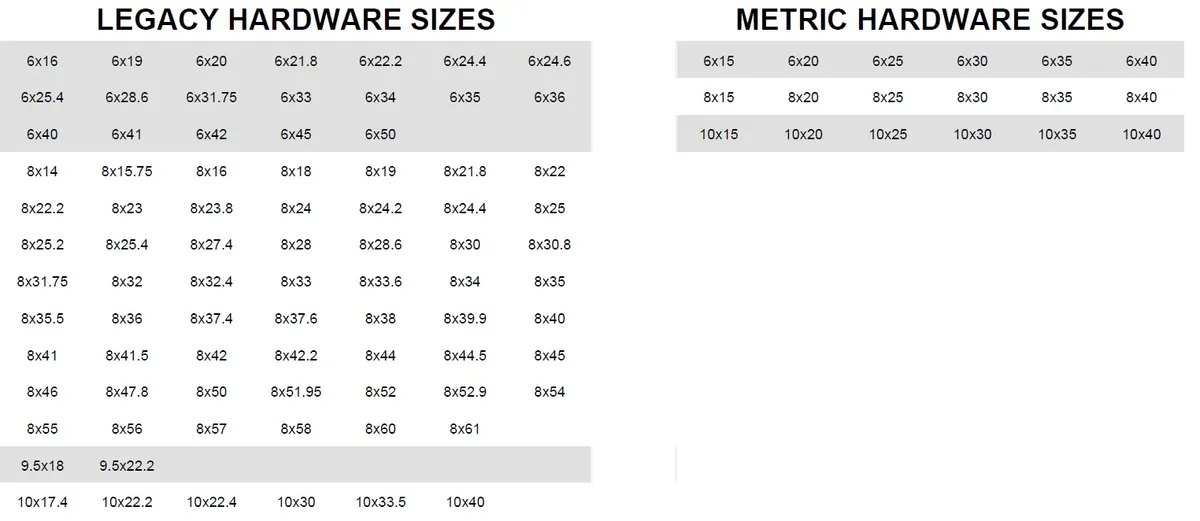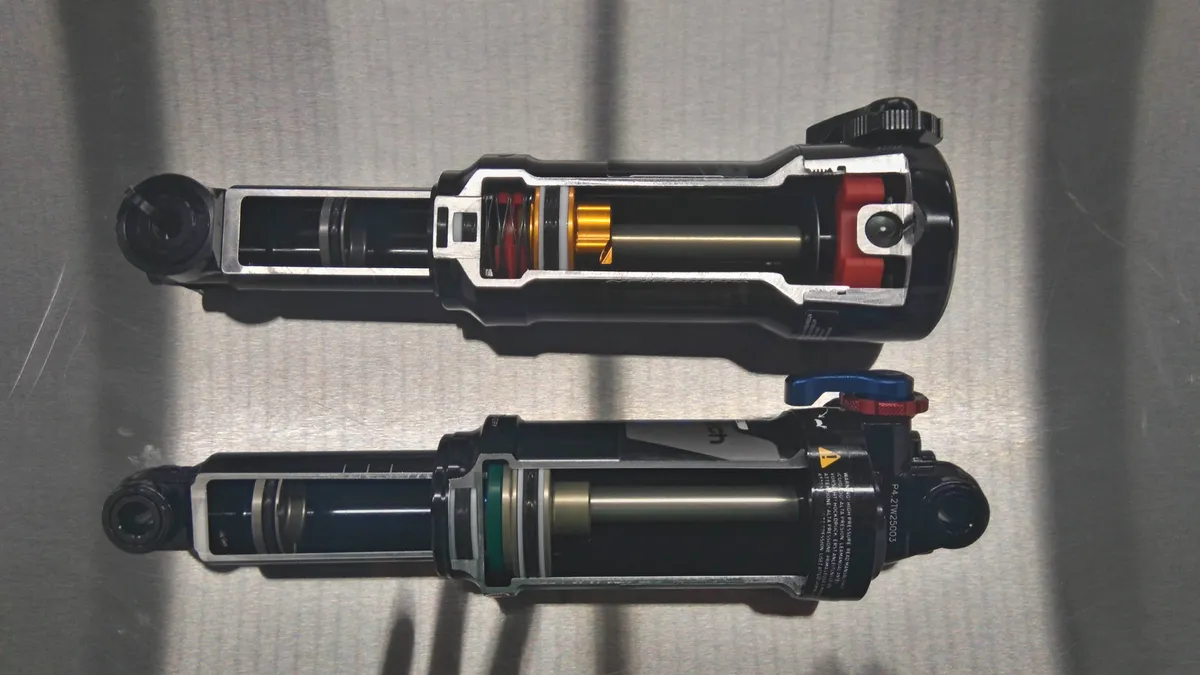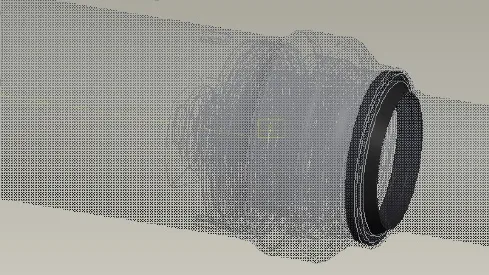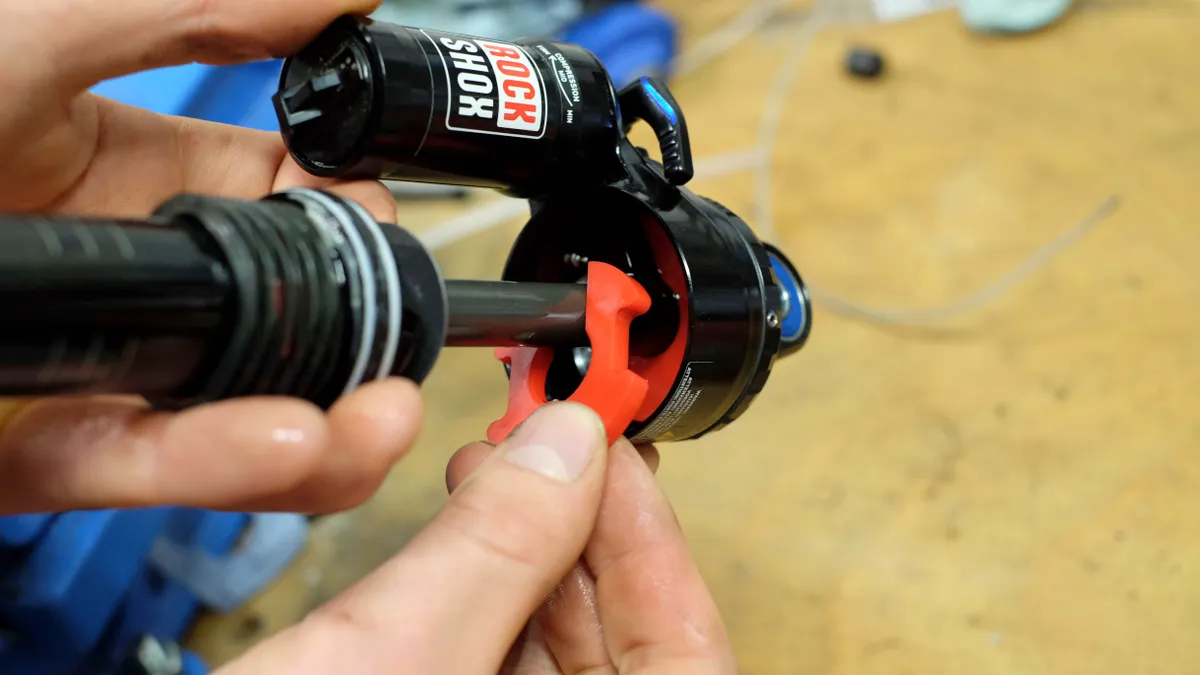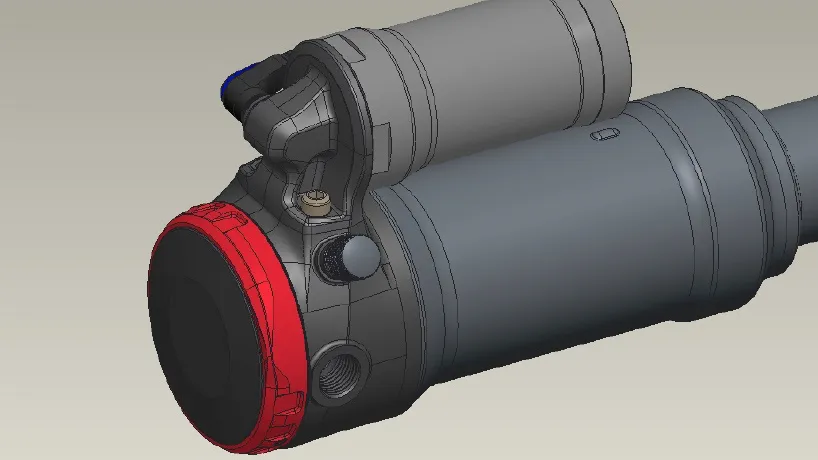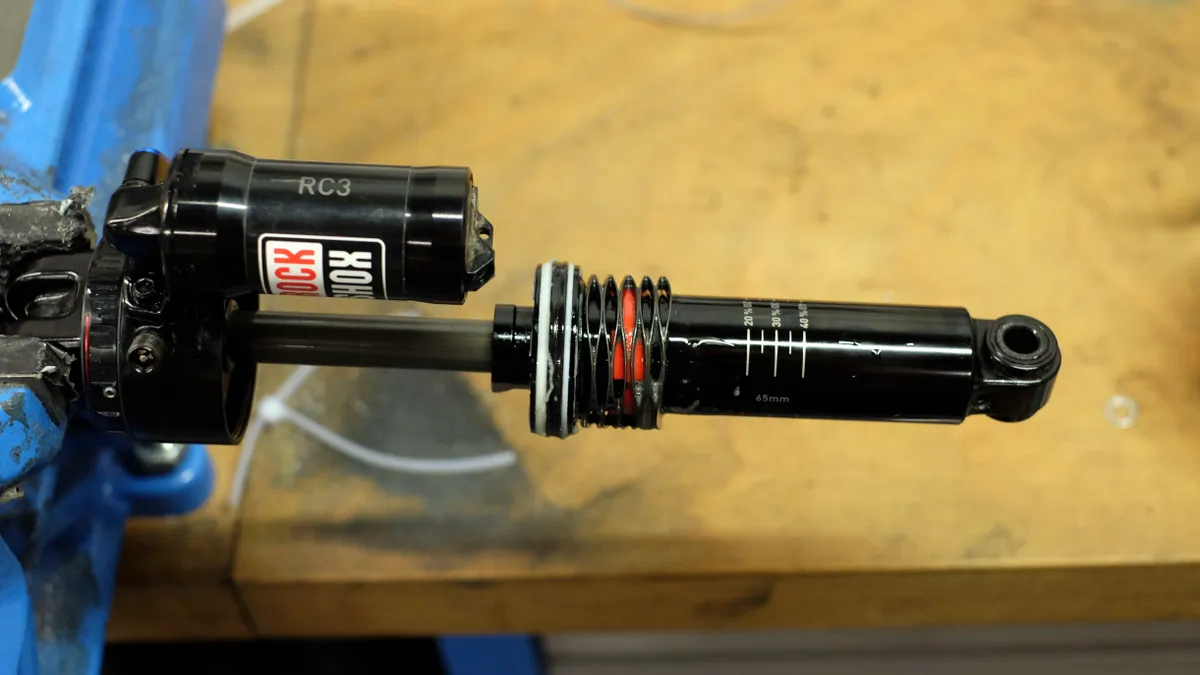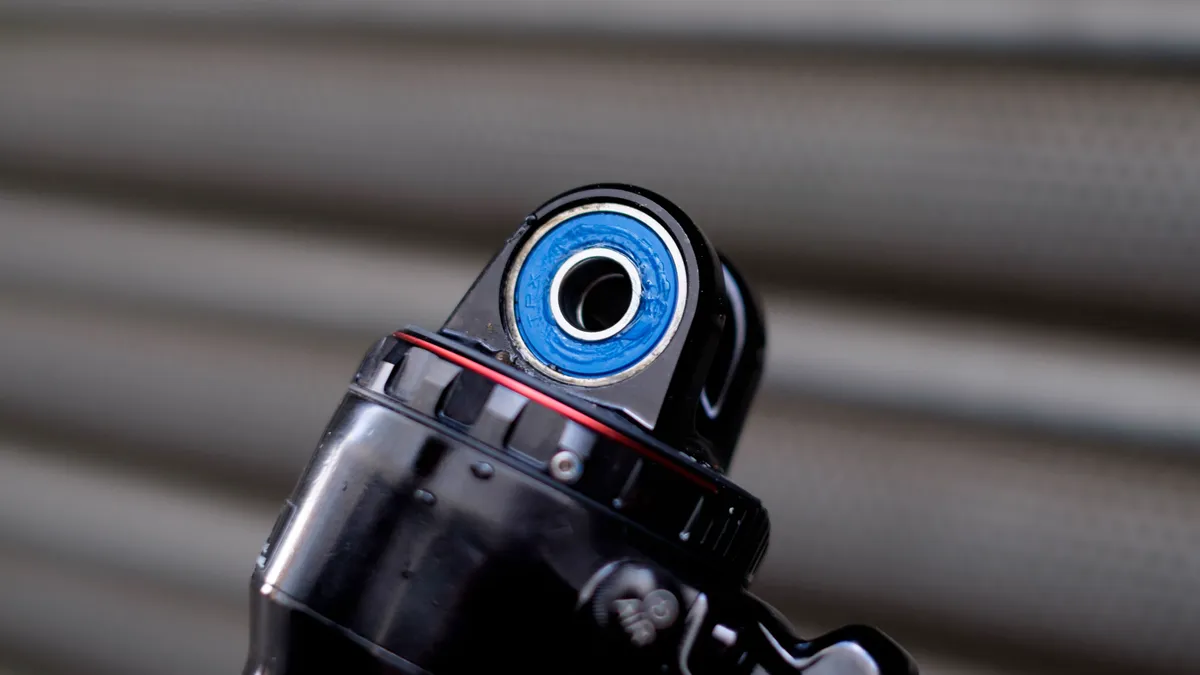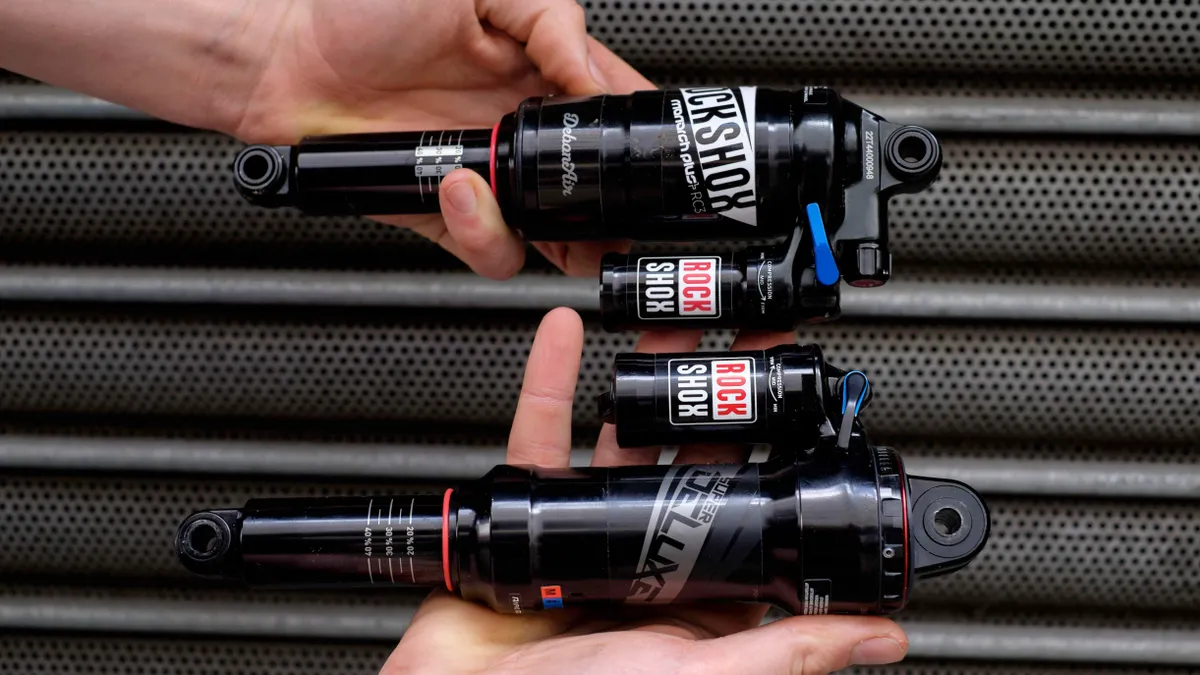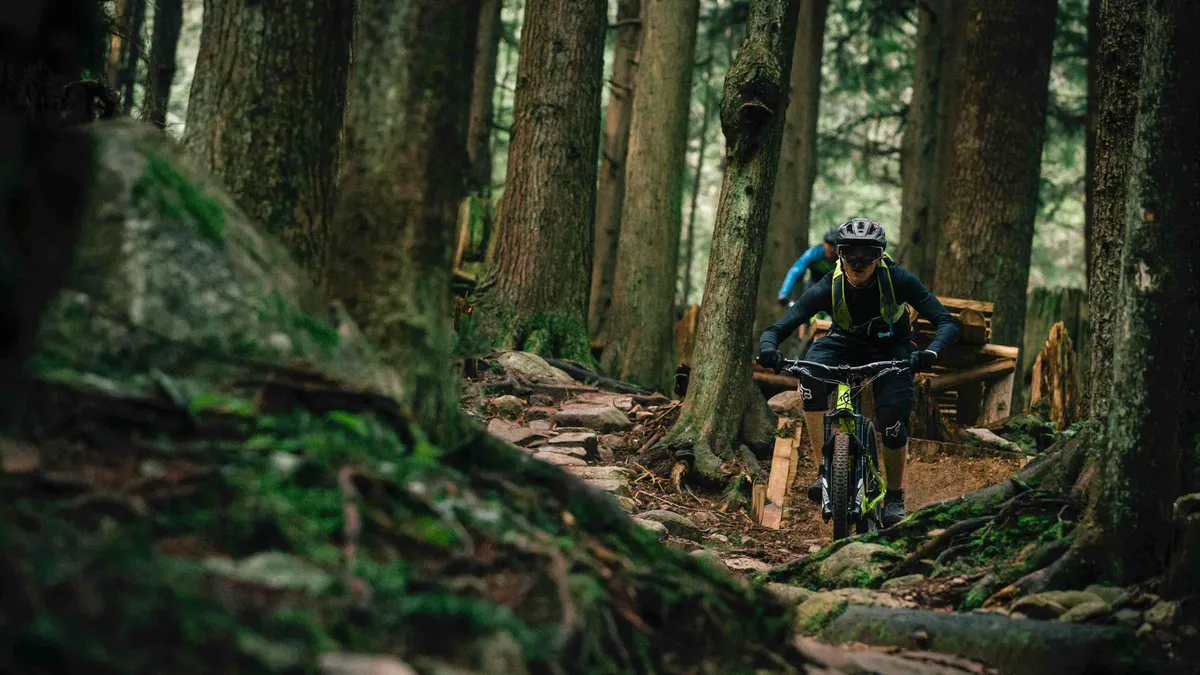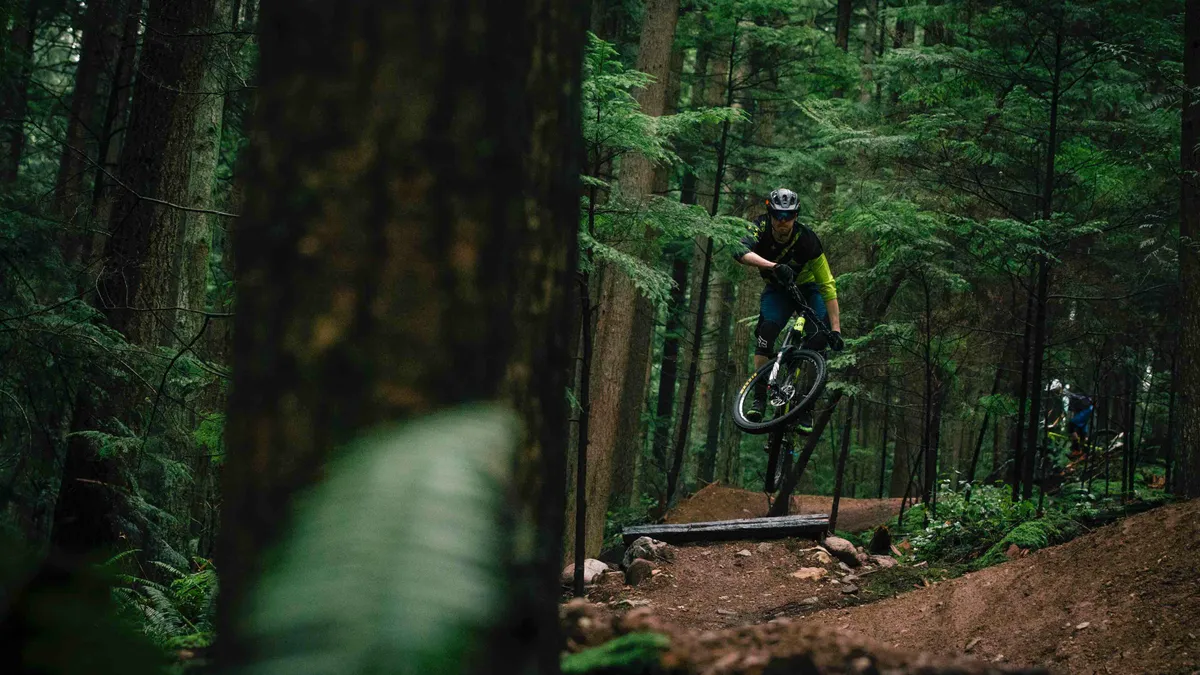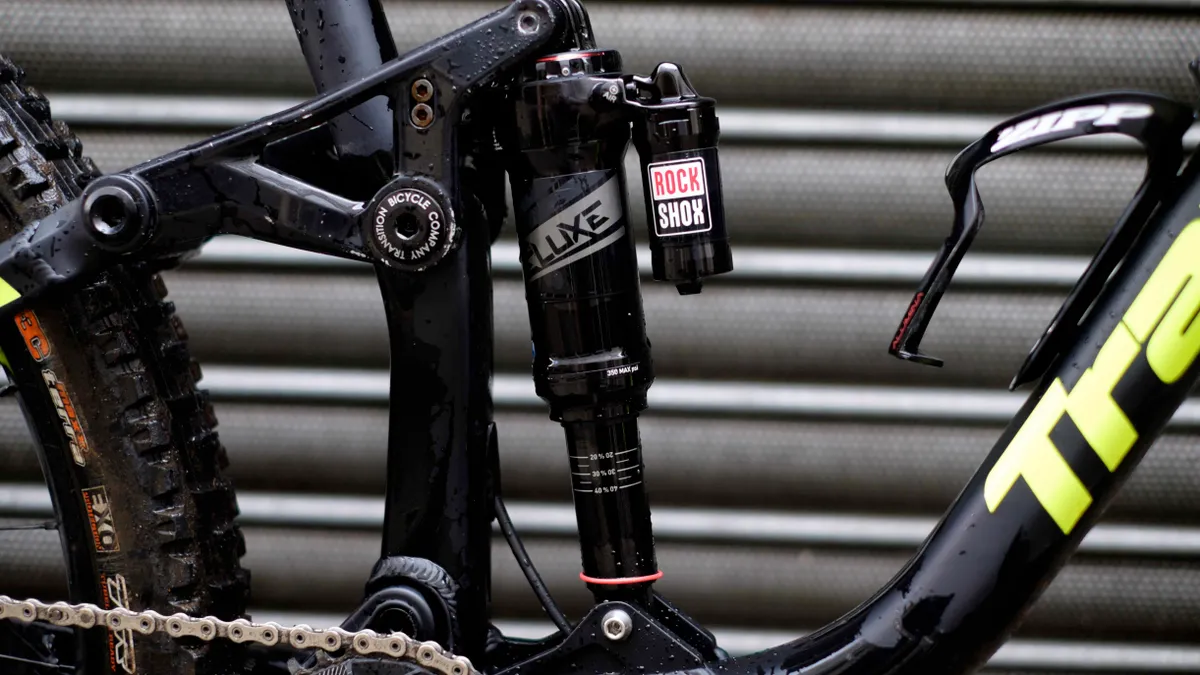RockShox has announced that, along with five other suspension manufacturers, they will be offering a new ‘rationalised’ set of shock sizes to the OEM market.
Essentially, they’ve condensed the current nine combinations of eye-to-eye lengths and shock strokes into six combinations, with nice even steps between them (three eye-to-eye lengths, with two stroke options in each).
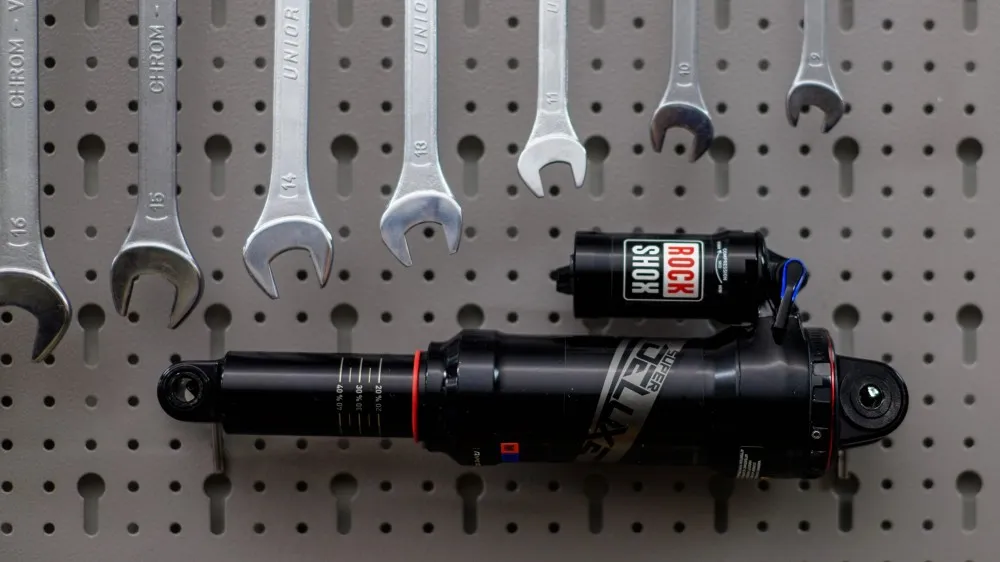
Similarly, they’ve also simplified the range of mounting hardware available, from 82 combinations to just 18. Rather than the ad-hoc range of sizes currently on the market, they’ve applied logic to this too.
The three options of bolt diameter will remain: 6, 8 and 10mm; while there are now just six widths in 5mm increments: 15, 20, 25, 30, 35 and 40mm. This should make it easier to measure and find the correct size of replacement hardware when it wears out.
What’s the point of this metric sizing?
The current range of hardware makes it very easy to mis-measure - a 21.8mm item is easily mistaken for 22mm, which has been known to result in the wrong size being ordered. With 5mm increments between sizes, this problem should be eliminated, unless you’re really very bad with a tape-measure. Also, with just 18 sizes available, it should be feasible for bike shops to stock all the available sizes – good luck finding a bike shop which does that now.
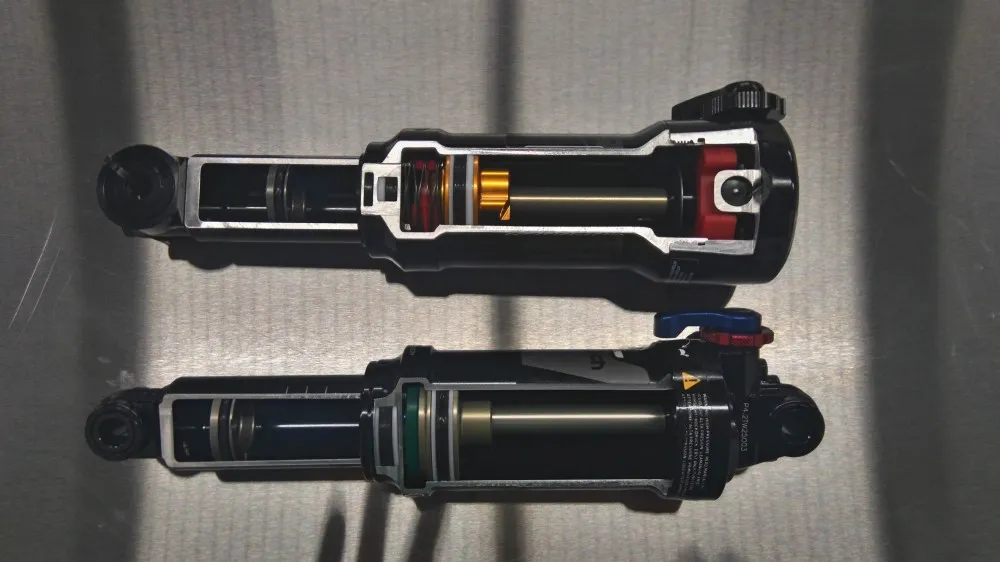
The reasons for going metric go beyond convenience, though. It’s all about performance. If you look at the table of eye-to-eye lengths and shock strokes, you’ll notice that the shocks have all got longer for a given travel. This affords the shock designers more room for the shock’s internals, which improves performance in a number of ways. When compared to the legacy Monarch shock, the new Deluxe damper showcases these advantages:
• There is now more bushing overlap, stiffening the connection between the shock’s shaft and body. This means the shock is less affected by lateral loading, which can result from flex in a frame, particularly during cornering. They claim friction is significantly reduced under these conditions.
• The wiper seal is now longer, which is claimed to reduce friction, especially in cold conditions, whilst lengthening service intervals.
• The volume spacers are now placed at the head of the body, rather than in a sleeve around the air can. This makes it easier for heat to dissipate.
• There is more room in the nitrogen-filled IFP chamber. This means the bottom-out force is less affected by the damping circuit, and can be tuned via the volume spacers. This is particularly important for shorter stroke shocks, which are often unable to reach full travel due to a lack of space behind the IFP.
Won’t the longer shock lengths prevent frame manufacturers fitting the shocks in their frames?
RockShox have thought of this. They offer, in parallel, a range of shocks which use a trunnion mount. This means the shock mounts to the frame via the sides of the shock body, rather than at the very end.
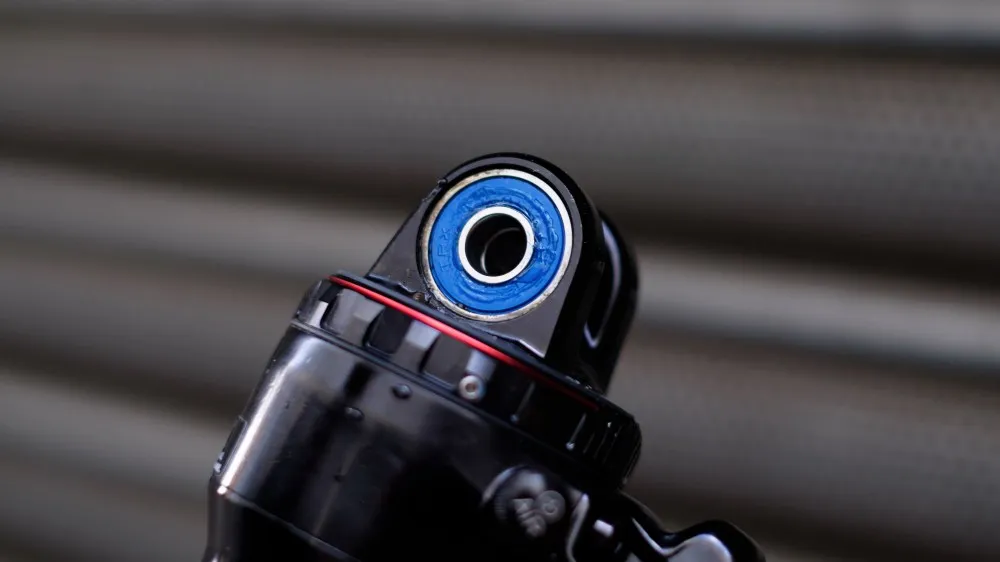
This shortens the eye-to-eye length by 25mm, without affecting the length of the shock internals. This is a similar system to that used on Trek’s Fuel and Remedy models, and should now allow other brands to fit longer-stroke shocks into frames with low top-tubes.
So I have to go out and buy a new frame and shock? Shall I express my displeasure in capital letters on my nearest internet forum?
Well, probably not. RockShox - and all other suspension brands - say they’ll continue to offer imperial sized-shocks to the aftermarket so long as there’s demand for them. Not all frame manufacturers are on board with the new shocks yet, so they’ll continue to offer imperial shocks to those brands too.
Who’s on board?
RockShox, along with Cane Creek, Manitou, DVO, SR Suntour and X-Fusion have agreed on the above metric sizes.
Fox says it will be supplying metric shocks to frame manufacturers too. Their official line on the subject is this: “Fox will continue to work with its customers to provide specific rear shock applications that best suit their frame designs. This support includes imperial, as well as, metric based applications.”
What else is new about the new Deluxe shock?
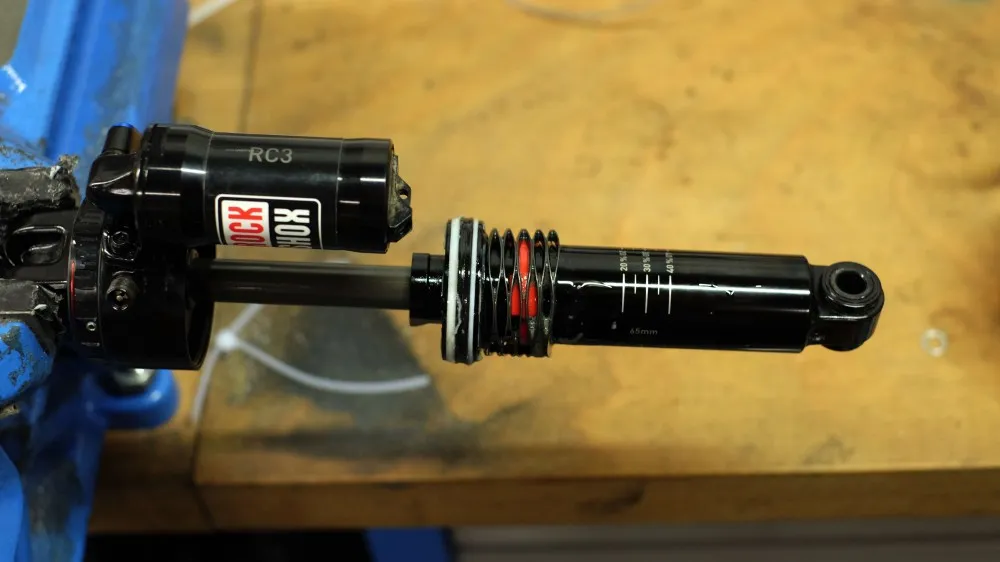
In addition to the performance benefits which are afforded by metric sizing, RockShox have incorporated a few other technologies in a bid to boost suppleness further.
• They’ve incorporated their ‘Counter Measure’ system, which was developed for the Vivid and Vivid air to increase suppleness. This is essentially a small coil spring which acts with the negative spring to get the shock moving at the start of the stroke, countering the effect of the IFP pressure.
• They’re offering bearing mounting systems. This can reduce friction significantly over traditional DU bushings, especially for bikes with a high degree of rotation at the shock eyelet. The trunnion mount is designed to fit into frame-mounted bearings to achieve a similar effect.
• The three compression settings (open, pedal, firm) on the RT3 models have been rethought for Deluxe. The pedal and firm modes use dedicated compression pistons to tune their firmness independently. The pedal mode is noticeably firmer then the Monarch’s and the firm mode is now a lockout.
The Deluxe is the metric equivalent to the inline version of the Monarch. Designed for XC and trail use, it will be available in four damping options:
RT3: External rebound, three-position compression (open, pedal, lock).
RT: External rebound, threshold.
RL: External rebound, lockout.
R: External rebound.
The Super Deluxe is aimed at the trail and enduro market, and features a piggyback reservoir for improved consistency on long descents. It will be available in two damping options:
RC3: External rebound, three-position compression (open, pedal, firm).
R: External rebound.
Riding the Super Deluxe

We rode the Super Deluxe RC3 for three days on the rocky and rooty terrain of Vancouver’s North Shore, before riding it on home soil. This gave us the opportunity to back-to-back test the Super Deluxe against the legacy Monarch Plus RC3. They were both fitted to the same Transition Patrol bike; although the rocker link had to be replaced with a custom machined version to accommodate the metric shock, SRAM assure us the frame’s kinematics were unaffected.
We set the sag to the same level on each (32% measured sitting down) and set the rebound to feel the same under the car park test. After bouncing on the saddle on flat ground, the shock should rebound just above the sag point, before settling back to sag without oscillation. This gets rebound to within a click or so of the ideal settings. This left us 10 clicks from closed on the Monarch (7 from fastest), and 9 from closed on the Deluxe (just 1 from fastest).
Hitting the trail, it was clear that the Super Deluxe was more active in its open mode: offering more comfort and traction than the Monarch Plus on seated technical climbs. The Pedal mode was noticeably more supportive than it was on the Monarch – great for steep climbs, but perhaps not the best compromise for some flatter, rougher terrain. The Firm mode was a full-blown lockout, which we rarely used off-road, but was handy for maximum efficiency on tarmac.
When testing back-to-back, the Deluxe proved its worth on one section in particular. After overshooting a chunky drop, a rocky off-camber left hander preceded a tight right. We rode this twice on the Monarch, before repeating it three times on the Super Deluxe. Each time, we used about the same amount of travel on the drop (around 95% or so), but we were able to brake harder and turn tighter across the rocks with the new shock.
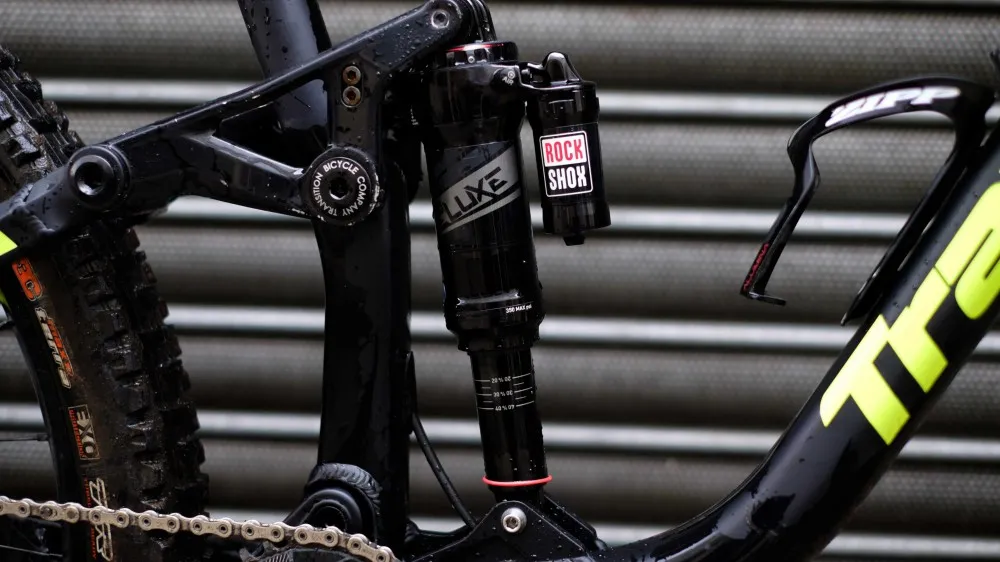
It appears to be noticeably more sensitive, especially under braking, resulting in improved traction which payed dividends on the trail. The Counter Measure and improved bushing overlap may account for this, but we suspect the bearing mount is a big part of it too.
We did notice we were clipping pedals more often on the Super Deluxe, which could be due to the decreased friction causing more suspension movement, but RockShox say they’ve increased the open-mode damping firmness slightly to compensate for this. The Deluxe uses a 65mm stroke rather than the Monarch’s 63mm. On the Patrol, this resulted in around 5mm more travel at the rear wheel - it could be that we were just noticing this.
Although we realise that RockShox are keen to keep things simple for the end-user, we would appreciate a fine-tuning dial for the compression damping in the open mode, similar to the RCT3 dampers seen on the brand’s Pike and Lyrik forks. This would add support for harder riders, and help it compete with Fox’s superb DPS and Float X dampers.
We experimented regularly with rebound settings. When set to its fastest, the rebound was by no means ridiculously bouncy. Chassis stability suffered on technical climbs, causing a little bucking after bumps. On the descents, it was slightly less predictable when leaving jumps, but sensitivity was sublime. More than two clicks from fully open, though, and the suspension was noticeably harsher over fast, repeated hits.

The fact that our 83Kg tester’s ideal rebound settings were just a click or two from fully open is worrying. Lighter riders will use less pressure to get the correct sag, and this means they will need lighter rebound damping still, and may struggle to get the shock returning fast enough.
With the slowest rebound setting being unusably slow without pumping the shock to really high pressures, it would appear RockShox needs to recalibrate their rebound range a touch. It could be that our sample had a fault, though, and we have put our concerns to RockShox.
Putting these concerns aside, the Super Deluxe offers a marked improvement in sensitivity over the Monarch plus, demonstrating the advantages of the metric shock system in the process.
